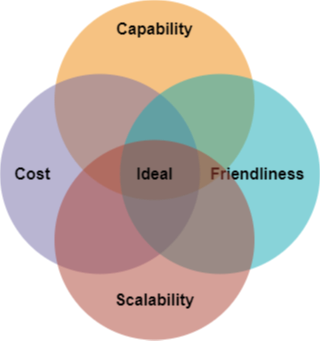I'll deal with that later...That should do for now...Save it for another day...Familiar?
Let's face it, if you're starting up in business there are so many hats to wear and things to consider that you will usually do what is easiest and gets you up-and-running quickest, in order to start earning money! That goes from choosing a website domain, company name, branding and IT systems. We are impatient to get started and full of motivation.
There are many elements of a business that can evolve and be changed easily later on as you develop your customer base. Unfortunately those mentioned above are VERY difficult to change once you are established for a significant time, particularly once you reach capacity whilst dealing with the challenges of growing pains. As a company grows it is common for people to implement a "sticky plaster" fix which solves the immediate issue but introduces more and more complexity.
The last thing anyone wants is to be forced into a situation where their choices early on come back to haunt them. In the IT industry we refer to the term technical debt, which is the result of opting for the easier solution now and delaying the inevitable consequences and work until the future. AKA, sweeping it under the carpet.
1. First Steps - Plan Ahead
My first piece of advice for anyone starting up or considering starting a business is to do your research. Articles like this one help and there are many more than can give you confidence before making decisions.
Don't leave it too late - You are in the ideal position to make some simple but crucial decisions for your business right now.
Have a 5 year plan - Where do you see your business going? How many clients, staff and products? Follow some simple business plan guides such as these from the Prince's Trust.
Avoid the temptation to create a "pick and mix" solution of software - Whilst it is entirely possible to bolt together any number of different systems, this quickly becomes complex, costly and plain dangerous to your business. Just because other's do it, doesn't mean it is the right way. We will talk more about this later on.
2. What Goes Wrong and Why?
As I mentioned above, we are keen to get up-and-running as soon as possible in a startup business. Particularly over the last year we have seen several hyper-growth startups that have grown exponentially, growing rapidly to a nationwide 200+ employee company with help from investors.
The risks to these startups is that they quickly reach a roadblock due to rapid increase in customers, suppliers and products. Soon they realise out of sheer desperation that their business model is in real danger of failure, attracting negative reviews from clients due to the inability of their systems to scale with the demand of their customer base.
Whether you are lucky enough to be one of those or regardless of your size, everyone should prepare for the need to scale-up with the least amount of effort.
The UK government and NHS are also prime examples, where they have grown to such a size that it is an almost impossible task to imagine replacing their core systems. Many attempts have been made in recent years with some projects failing and losing vast amounts of money. When you reach this level of complexity, however much money you throw at a problem, it is never enough. What is needed is a re-think of strategy and a lot of smart minds. This unfortunately takes a lot of time.
3. Assess the Value of Data
Your data probably feels small and simple compared to the sheer scale of information that is available in our modern world.
The world runs on data and it is growing rapidly. Worldwide data storage has grown from 2 Zettabytes in 2010, to a predicted 180 by 2025! (Zettabyte = 1e+12 Gigabytes)
Although you may never reach the levels of data stored by companies like Google, Facebook and Amazon, your own data is extremely valuable to you, your clients and business. One of the biggest challenges is to have easy access to your data for all needs, whilst still keeping it simple, manageable and centralised.
Example of poor data management
All of us have used spreadsheets, here is a common scenario:
Start with a simple spreadsheet that has all of your clients contact details. Quickly you realise that this should be imported into another program (Outlook for email contacts). Next you need to use this information in your accounts software so you import that also. Finally, you need to produce invoices and sales orders so find yourself manually copying contact data into documents.
Even in this case you already lose track as there are 4 duplicate copies of contacts, which one is the MASTER contact, what do you do if a client changes their address?
Some issues arising include:
Wasted Time
Increased Human Error
Potential lack of GDPR (General Data Protection Regulation) or PCI (Payment Card Industry) compliance
The drawbacks might seem small when you are dealing with a handful of clients. But imagine you needed to handle 50, 100 or even 1000 clients? Multiplying the time it takes quickly becomes unmanageable and you would be considering hiring staff to assist you.

4. Scalability - Think Big
Most systems start as a document or spreadsheet. However the rule should be followed that if it contains core business data (customer/supplier contact details, sales order information, product details) or anything liable to need to change, then you should stop and consider if this is the right place to keep it.
One of the first roadblocks reached is when you have to share responsibilities with another member of staff. The quickest way to know if your business is scalable is to ask a friend to try to carry out one of your daily tasks. Create a simple procedure and see if it can be followed. Then, attempt to also do this at the same time as them. If you are both sharing a document, this becomes a problem as you are fighting over the data.
Google Docs and Office 365 have made sharing and collaborating on documents achievable, but it is not designed to be a scalable option. Just try sharing a spreadsheet with 5 people and see how them all editing in parallel ends up!
Even when dealing with a small number of clients, you may find yourself limited by other areas of the business such as order processing, project management. If you find any part of the business is eating up too much time in administrative work, chances are there is a better way.
5. Software Solutions - How do I choose?
The most important piece of advice when choosing software with all of this in mind is to ask yourself the question, should use multiple tools or is there something that can combine all my needs into one?
You may be concerned about the risks of putting all your eggs in one basket as the saying goes. This is a legitimate concern and you should always ensure that any software selected is mature, well regarded and importantly has backup/redundancy considered so you can feel confident and be in control of your data.
When selecting software you have a huge array of choices available, which can be overwhelming. There are established major commercial products, open-source products and free or low-cost options. Here at OUS we specialise in the open-source and lower cost solutions and believe you should always consider one of these before opting for the more common, often high-priced commercial options.
However, you should to have realistic expectations and the following diagram should help give an idea of the sweet spot between the 4 characteristics of great software.
If you can find something that ticks as many of of these boxes as possible, you are on to a winner!

6. Systems ALL Businesses Need
If you are doing business, chances are you have customers they pay you, you take enquiries, need to track your products / services and expenses, communicate, use a bank and probably do some promotional marketing online and via a website. This means that the majority of businesses with an online presence nowadays, should consider the following services a minimum:
CRM (Customer Relationship Management)
Email
Calendar
Project + Time Management
Invoicing and Accounting
Website
Data Storage
Phone
Video Conferencing
Social Media (possibly automated)
As you can see, already that is 10 systems and potentially many more if you decided to pick a multitude of different "best of breed" solutions. However it is possible to combine many of those requirements into single platforms which makes for a much more centralised, affordable and ultimately scalable solution. As an example, here at OUS we use:
Odoo: CRM, Project and Time Management, Invoicing and Sales and Website and Marketing
Office 365: Email, Calendar, Data Storage, Video Conferencing
Other systems: Integrated to pull data from Odoo and Office 365
If you can combine several services such as these you are well on your way to a scalable business structure which can grow with your needs, provided your core business data is kept on a maximum of 3 systems, with all contact data in a SINGLE place (database).
You may find that in your own specific industry, there are certain proprietary software systems you need to use e.g AutoDesk or Adobe Creative Suite. I would advise you research any open-source options for these and if they are not suitable, it may be necessary to consider them an exception to the rule.
Links below should help.
- AlternativeTo - Crowdsourced software recommendations
- A list of the top Open-Source solutions of 2021
Conclusion and Next Steps
It is a common misconception that all of this requires huge budgets, massive developer bills and being tied into contracts with persuasive software sales companies for a particular product. This is no longer true if you take care to do the research and not rush into making decisions.
As a startup today, you have enormous potential to delight your customers with the impressive level of organisation in your business, whilst being a strong competition even as a sole trader or small business. Taking steps early on to ensure you can scale-up when needed gives you confidence in the future.
If you get this right, you can focus on what you are best at, delivering your own unique value to clients and not feeling like a data-entry monkey!
I hope this has helped you. If you want to chat about your business needs, feel free to get in touch to see if we can help you.